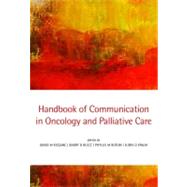
| Preface | p. ix |
| Foreword | p. xi |
| Foreword | p. xiii |
| Contributors | p. xv |
| Introduction to communication studies in cancer and palliative medicine | |
| The history of communication skills knowledge and training | p. 3 |
| The art of teaching communication skills | p. 13 |
| Theoretical models of communication skills training | p. 27 |
| Shared treatment decision-making and the use of decision-aids | p. 41 |
| The ethics of communication in cancer and palliative care | p. 51 |
| Gender, power, and non-verbal communication | p. 63 |
| Medical student training in communication skills | p. 75 |
| Enhancing cancer patients' participation in medical consultations | p. 87 |
| A core curriculum for communication skills training for oncology and palliative care | |
| Breaking bad news | p. 101 |
| Discussing prognosis and communicating risk | p. 113 |
| Communication training to achieve shared treatment decisions | p. 127 |
| Responding to difficult emotions | p. 135 |
| Denial and communication | p. 147 |
| Communicating with relatives/companions about cancer care | p. 157 |
| Conducting a family meeting | p. 165 |
| Communication about coping as a survivor | p. 177 |
| Dealing with cancer recurrence | p. 191 |
| Communication about transitioning patients to palliative care | p. 203 |
| End-of-life communication training | p. 215 |
| A specialty curriculum for oncology | |
| Enrolment in clinical trials | p. 231 |
| Working as a multidisciplinary team | p. 245 |
| Communicating genetic risk | p. 259 |
| Rehabilitative and salvage surgery | p. 269 |
| Discussing unproven therapies | p. 281 |
| The effect of internet use on the doctor-cancer patient relationship | p. 293 |
| Promoting treatment adherence | p. 303 |
| Communication strategies and skills for optimal pain control | p. 315 |
| Discussing adverse outcomes with patients | p. 327 |
| Clinical perspectives on shared decision-making | p. 339 |
| Audio-recording important consultations for patients and their familities-putting evidence into practice | p. 351 |
| Working with interpreters and achieving culturally competent communication | p. 361 |
| Challenges in communicating with ethnically diverse populations | p. 375 |
| Intercultural communication in palliative care | p. 389 |
| Communicating about infertility risks | p. 399 |
| Communicating about sexuality in cancer care | p. 409 |
| Communication issues across the disciplines | |
| The challenges and rewards of communication skills training for oncology and palliative care nurses in the United Kingdom | p. 425 |
| Ambulatory care nurses responding to depression | p. 439 |
| Social work support in settings of crisis | p. 449 |
| Communication in cancer radiology | p. 459 |
| Communication in surgical oncology | p. 473 |
| Communication in non-surgical oncology | p. 479 |
| Palliative medicine: communication to promote life near the end of life | p. 491 |
| Communication issues in pastoral care and chaplaincy | p. 503 |
| Communication in oncology pharmacy: the challenge of treatment adherence | p. 509 |
| Psychosocial programme development | p. 521 |
| Communication challenges with the elderly | p. 531 |
| Issues for cognitively impaired elderly patients | p. 547 |
| Communicating with children when a parent is dying | p. 557 |
| Creative arts in oncology | p. 573 |
| Education and training | |
| Learner-centred communication training | p. 583 |
| Facilitating skills practice in communication role-play sessions: essential elements and training facilitators | p. 597 |
| The role of the actor in medical education | p. 607 |
| Training patients to reach their communication goals: a concordance perspective | p. 619 |
| International initiatives in communication training | |
| The Oncotalk model | p. 631 |
| The Swiss model | p. 641 |
| The Australian model | p. 649 |
| The United Kingdom general practitioner and palliative care model | p. 659 |
| Communication skills training and research: the Brussels experience | p. 671 |
| Research in cancer communication | |
| Evaluating communication skills training courses | p. 683 |
| Qualitative approaches to clinician-patient communication | p. 695 |
| Issues in Coding Cancer Consultations: interaction analysis systems | p. 707 |
| The Roter Interaction Analysis System (RIAS): applicability within the context of cancer and palliative care | p. 717 |
| Table of Contents provided by Ingram. All Rights Reserved. |
The New copy of this book will include any supplemental materials advertised. Please check the title of the book to determine if it should include any access cards, study guides, lab manuals, CDs, etc.
The Used, Rental and eBook copies of this book are not guaranteed to include any supplemental materials. Typically, only the book itself is included. This is true even if the title states it includes any access cards, study guides, lab manuals, CDs, etc.